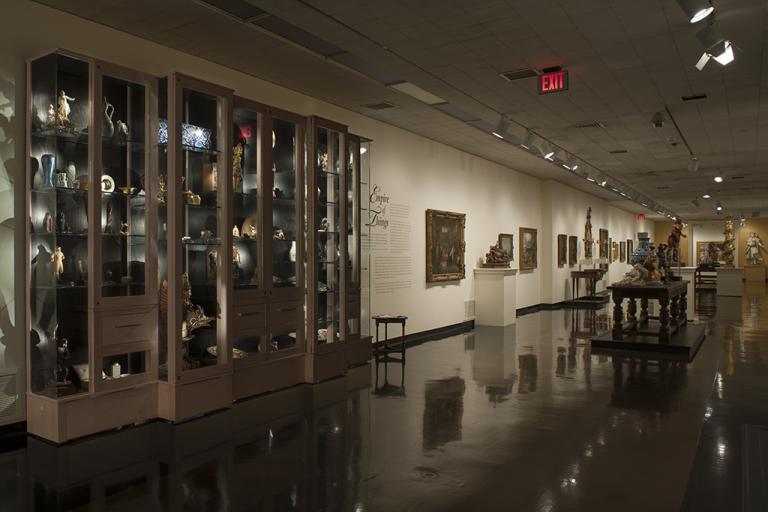Exhibition Label:
"Empire of Things," 2013, Kate Meyer
Working with a circle of other foreign-born painters in 17th century Rome, Claude Lorrain, often simply called Claude by English-speaking audiences, pioneered the development of the landscape genre. Because landscape paintings were considered too secular for painters in Rome, Claude always included a few human figures as the ostensible subjects of his work. Clearly, though, his true interest lay in the landscapes he rendered with remarkable consistency. Claude spent long hours making detailed sketches in the countryside, especially at sunrise and sunset, mixing his colors on the spot. He returned to his studio to work out his compositions and execute the paintings. These practices explain two of the defining characteristics of Claude’s landscapes: the delicate balance between idealism and naturalism, and the luminous golden light that suffuses each scene. Claude’s style proved immensely popular and continued to be widely imitated for more than two centuries after his death.
Archive Label 1999:
Claude was given his traditional surname of "Lorrain" (in reference to his birthplace in northeastern France) in Rome where he studied painting and settled permanently in 1627. By the end of the 1620s Claude was a very desirable artist, whose works were being faked and copied, a fact that caused the artist considerable concern. These fakes forced the artist to develop a book of compositional drawings, known as the Liber Veritatis, or "Book of Truth," to document his finished paintings and prevent further erosion of his reputation.
The Spencer's painting is one of these early works executed before the establishment of the Liber. While one distinguished expert on Claude's paintings believes the work on loan from the Metropolitan Museum is a version by Claude himself, it is more likely to be one of the few surviving contemporary seventeenth-century imitations that forced Claude to begin documenting his compositions.
A Question of Attribution
Only one of these two paintings is signed, but both have been attributed to Claude Lorrain. How do experts assign works of uncertain authorship to an artist? Modern art historians have at their disposal a number of reliable means by which to verify authenticity. These range from documentary evidence, such as that relating to a work's provenance or history of ownership, to highly sophisticated laboratory examination. However, the burden of attribution ultimately rests on the shoulders of an expert whose experienced eye, trained through numerous close encounters with an artist's work, enables him or her to recognize a painter's hand. Theoretically, each artist has a characteristic manner of painting that can be identified by the trained eye almost as handwriting.
However, because a scholar forms a personal interpretation of an artist's style, opinions on attribution may vary and, as these examples demonstrate, sometimes conflict. Three experts have agreed that the Spencer Museum painting is a genuine Claude; two of them have labeled the Metropolitan version a 17th-century copy. The third scholar, believing the work to be from Claude's hand, says it is conceivable that Claude painted two versions of the same composition, perhaps for his own satisfaction, perhaps at the request of a patron. On the other hand, Claude complained of artists who stole his compositions, imitated his manner, and sold works under his name in Rome. In the early 1630s the artist began a catalogue of drawings called the Liber Veritatis, to document his own works and confute would-be forgers.
In general, the Spencer work seems to reveal a more competent hand when conveying the subtleties of spatial recession, light and dark contrasts, and weight of three-dimensional forms. One scholar has commented on the convincing depiction of the group of trees and ruins in the Spencer work that exist "solidly and three-dimensionally in space," while those of the Metropolitan's painting seem "lightly drawn on the surface." In the distant background the subtle tonal variations of the Spencer picture are replaced in the second version by sharply accentuated blue. Such discrepancies in handling may be the work of a less-accomplished forger or, according to one authority, the inexperience of Claude's youth. This side-by-side comparison enables viewers to draw their own conclusions.












